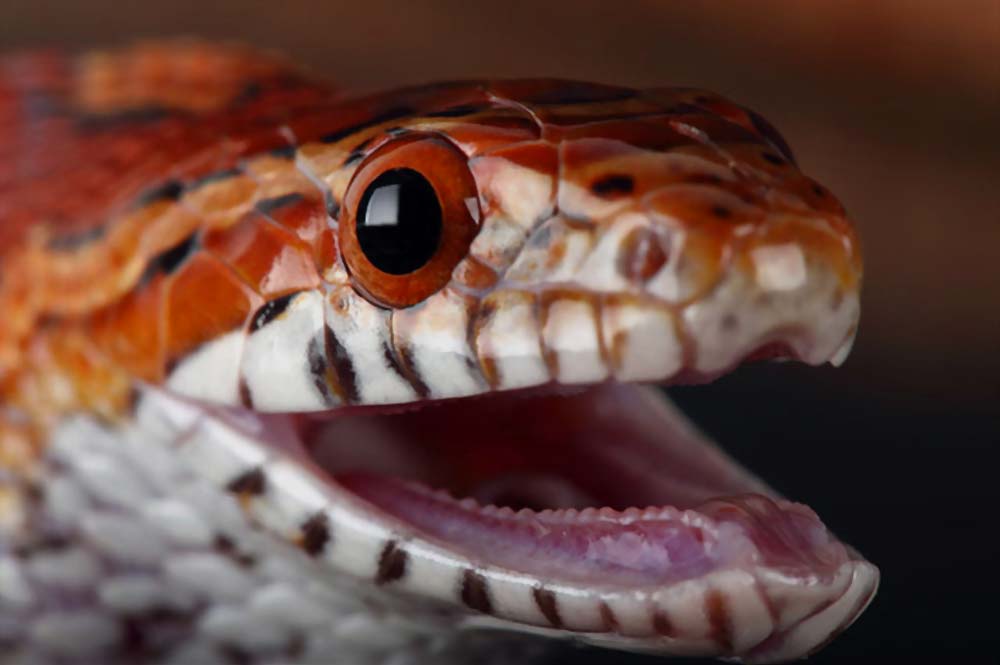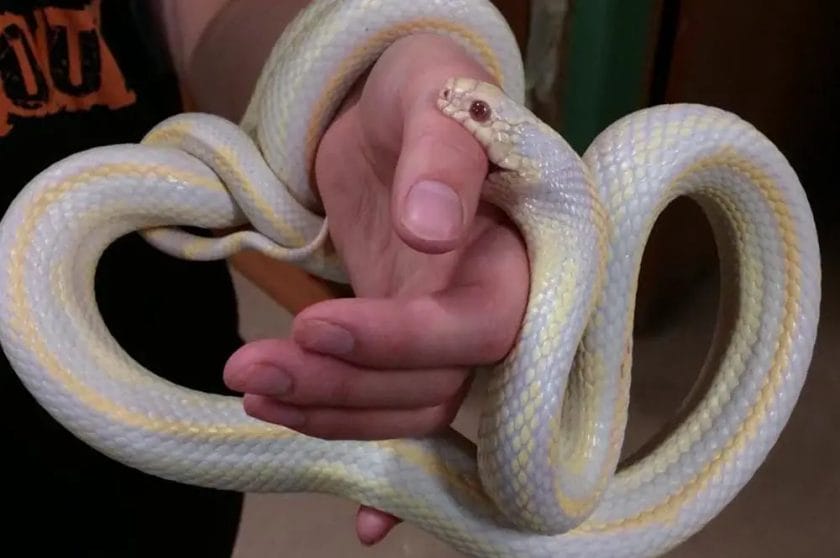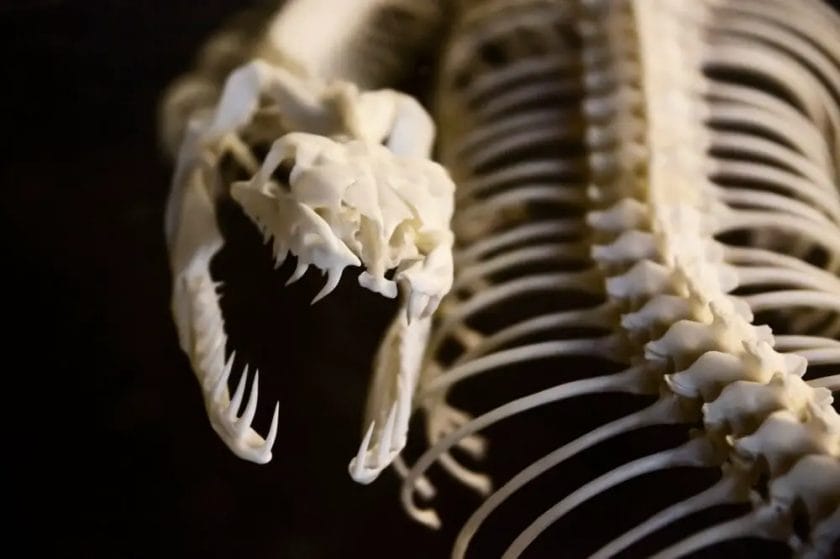A snake indeed has teeth, but the arrangement and type of teeth vary among different species. Most snakes possess sharp, backward-curving teeth known as fangs, which are used to capture and immobilize their prey. These fangs deliver venom to help in hunting or defense. However, not all snakes are venomous, and some species have teeth that are better suited for grasping and swallowing their prey. Whether venomous or not, the teeth of a snake are an essential tool for its survival and feeding.

Venomous Snake Teeth: Understanding the Function and Composition
In the world of reptiles, venomous snakes have evolved a remarkable adaptation that sets them apart from non-venomous species – their specialized teeth. These teeth are not only sharp and deadly, but they also play a crucial role in delivering venom to their prey or potential threats. In this section, we will delve into the fascinating function and composition of venomous snake teeth, shedding light on their unique evolutionary development.
1. Fanged Weapons of Destruction
One of the defining features of venomous snakes is their fangs. These elongated, hollow teeth are specifically designed to inject venom into their prey. Unlike the teeth of non-venomous snakes, which are primarily used for gripping and swallowing prey whole, venomous snake teeth are adapted for a more sinister purpose.
The fangs of venomous snakes are located in the upper jaw, towards the front of the mouth. They may vary in size, shape, and position depending on the species. For example, vipers possess large, curved fangs that fold back when not in use, while elapids have smaller, fixed fangs at the front of their mouths.
The venom delivery system relies on a unique mechanism. When a venomous snake strikes, its fangs puncture the skin, allowing venom to flow through the hollow teeth and into the wound. This method ensures a rapid and efficient transfer of venom, maximizing the snake’s chances of subduing its prey or defending itself against potential threats.
2. Composition of Venomous Snake Teeth
The composition of venomous snake teeth showcases the remarkable adaptations that have evolved over millions of years. These teeth are composed of various materials that contribute to their formidable function.
a. Enamel: Enamel is the outermost layer of the tooth, providing it with strength and protection. In venomous snake teeth, the enamel is specially reinforced to withstand the forces exerted during strikes. It also helps to retain the sharpness and shape of the fangs, ensuring their effectiveness in delivering venom.
b. Dentin: Beneath the enamel lies dentin, a hard and dense tissue that forms the bulk of the tooth. Dentin gives the fangs their structural integrity and acts as a conduit for delivering venom. Additionally, dentin contains microscopic tubules that connect to the tooth’s nerve endings, enabling the snake to sense vibrations and changes in the environment.
c. Venom Channel: Running through the center of each fang is a hollow venom channel. This channel allows venom to flow from the gland at the base of the fang and exit through the tip. The size and shape of the venom channel may vary among species, influencing the volume and speed of venom delivery.
3. Adaptations for Efficient Venom Delivery
Venomous snake teeth have undergone remarkable adaptations to maximize the efficiency of venom delivery. These adaptations ensure that the venom reaches its target quickly and effectively.
a. Fang Length and Position: The length and position of the fangs play a crucial role in determining the efficiency of venom delivery. Longer fangs are capable of penetrating deeper into prey, allowing venom to reach vital organs more effectively. Additionally, the position of the fangs influences the angle at which the snake strikes, optimizing venom injection.
b. Venom Yield: Different species of venomous snakes produce varying amounts of venom per bite. Some species, like the saw-scaled viper, have relatively small fangs but can deliver a significant amount of venom with each strike. This adaptation ensures that a sufficient quantity of venom is injected, increasing the chances of subduing prey or deterring threats.
c. Venom Composition: The composition of snake venom is a complex mixture of proteins and enzymes that varies among species. The venom’s composition determines its effects on the snake’s prey or potential predators. Some venoms are neurotoxic, targeting the nervous system, while others may be hemotoxic, affecting the blood and tissues of the victim.
In summary, venomous snake teeth are a marvel of evolution, finely tuned for their deadly purpose. From their specialized fangs to the intricate composition of their teeth, these adaptations enable venomous snakes to effectively inject venom into their prey or potential threats. Understanding the function and composition of venomous snake teeth not only deepens our appreciation for these fascinating creatures but also provides insights into the intricate complexities of nature.

Non-Venomous Snake Teeth: Examining the Adaptations for Feeding
Snakes are fascinating creatures, known for their unique adaptations that help them thrive in diverse environments. One of the most intriguing aspects of a snake’s anatomy is their teeth. While some snakes possess venomous fangs, many non-venomous snakes have their own set of intriguing dental adaptations that allow them to capture and consume their prey efficiently.
Unlike venomous snakes, non-venomous snakes rely solely on their teeth to subdue and ingest their food. These teeth serve different purposes during the different stages of the feeding process.
Different Types of Non-Venomous Snake Teeth
Non-venomous snakes are equipped with a variety of tooth types, each playing a specific role in their feeding mechanism. The two main types of teeth found in most non-venomous snakes are:
- Front Teeth (Incisors): Located in the front of the snake’s mouth, the incisors are sharp, slender, and curved. They are primarily used to grab and hold onto prey, ensuring a secure grip during feeding. These teeth help prevent the prey from escaping while the snake positions itself for swallowing.
- Back Teeth (Rear-fanged): Positioned towards the back of the snake’s mouth, the rear-fanged teeth are longer and more serrated compared to the front teeth. These teeth are responsible for manipulating and guiding the prey towards the throat for swallowing. They assist in breaking down larger food items into more manageable pieces.
Feeding Mechanism of Non-Venomous Snakes
The feeding process of a non-venomous snake begins with locating and capturing its prey. Once the prey is within striking range, the snake will strike and bite down on the prey using its front teeth. The sharp incisors allow the snake to latch onto the prey securely.
After securing its grip, the snake utilizes its rear-fanged teeth to manipulate the prey and guide it towards the throat. The serrated edges of these teeth aid in tearing and breaking down the prey into smaller pieces for easier swallowing. The snake’s powerful jaws and flexible skull allow it to consume prey much larger than its own head.
Once the prey is positioned correctly, the snake begins the process of swallowing. Unlike mammals, snakes do not have the luxury of chewing their food. Instead, they rely on their highly flexible and expandable jaws to engulf the prey whole. The rear-fanged teeth continue to guide the prey further down the snake’s throat until it reaches the stomach.
Adaptations for Efficient Feeding
Non-venomous snakes have evolved a range of adaptations that enhance their feeding efficiency. These include:
- Jaw Flexibility: The ability to open their mouths wide allows snakes to consume prey much larger than their own head size. This adaptation is made possible by an intricate network of ligaments and muscles that enable their jaws to stretch and expand. It also enables them to dislocate their jaws temporarily to accommodate the prey.
- Elongated Skull Structure: Non-venomous snakes possess elongated and flexible skulls, which aid in swallowing larger prey. The bones in their skull are loosely connected, allowing for greater mobility and flexibility during feeding.
- Diverse Tooth Structures: The combination of sharp, curved incisors and serrated rear-fanged teeth enables non-venomous snakes to efficiently capture, manipulate, and swallow their prey. These teeth work together to ensure a successful feeding process.
In summary, non-venomous snakes have adapted their teeth and feeding mechanisms to effectively capture and consume their prey. The front teeth provide a secure grip, while the rear-fanged teeth aid in manipulating and guiding the prey towards the throat. With their jaw flexibility and elongated skull structure, non-venomous snakes are able to consume prey much larger than themselves. These remarkable adaptations highlight the incredible diversity and efficiency of these fascinating reptiles.

Shedding Snake Teeth: Unraveling the Mysterious Process of Tooth Replacement
Snakes are fascinating creatures known for their unique ability to swallow their prey whole. But have you ever wondered how they manage to do that without damaging their teeth? Snakes have a remarkable tooth replacement process that allows them to shed their old teeth and grow new ones. In this section, we will dive into the intricacies of this mysterious process and explore how snakes keep their teeth in top condition.
The Lifespan of Snake Teeth
Unlike humans and many other animals, snake teeth are not permanently rooted in their jaws. Instead, they have a specialized dental structure that allows for continuous replacement throughout their lives. Snakes are polyphyodonts, meaning they have the ability to replace their teeth multiple times.
A snake’s teeth are primarily used for capturing and immobilizing their prey, as well as for defense. Over time, these teeth can become worn down or broken, and that’s where the tooth replacement process comes into play.
The Process of Tooth Replacement
So, how exactly do snakes replace their teeth? It all starts with the development of new teeth. Behind each functional row of teeth, there are several replacement teeth waiting to take their place. As the old teeth become worn or damaged, the new teeth start to grow and push the old ones forward.
Once the replacement teeth start emerging, the old teeth are gradually absorbed by the surrounding tissues, eventually falling out. The new teeth continue to grow and move into position, ensuring that the snake always has a fresh set of teeth ready for action.
Factors Influencing Tooth Replacement
Several factors can affect the tooth replacement process in snakes. One of the main factors is the snake’s diet. Snakes that consume softer prey may not experience as much wear and tear on their teeth, resulting in slower tooth replacement. On the other hand, snakes that feed on harder prey or use their teeth for defense may go through tooth replacement at a faster rate.
The size of the snake and its species can also influence tooth replacement. Larger snakes tend to have more teeth and go through the process more frequently compared to smaller species. Additionally, some snake species have unique tooth replacement patterns, with teeth in different parts of their mouth being shed at different times.
The Importance of Tooth Replacement for Snakes
Tooth replacement is crucial for snakes to maintain their hunting efficiency and overall oral health. A set of healthy teeth allows snakes to capture and consume their prey effectively, ensuring their survival in the wild. Without the ability to replace their teeth, snakes would gradually lose their ability to eat and defend themselves.
In summary, snake tooth replacement is a fascinating and essential process that enables these reptiles to maintain their dental health. The continuous growth and replacement of teeth ensure that snakes always have functional and efficient tools for survival. Understanding this intricate process sheds light on the incredible adaptations found in the animal kingdom.
Snake Dental Care: Tips for Maintaining Healthy Teeth in Captive Snakes
Snakes, like any other living creature, require proper dental care to maintain their overall health and well-being. Healthy teeth are essential for a snake’s ability to feed, defend themselves, and maintain proper oral hygiene. In this section, we will discuss some important tips for maintaining healthy teeth in captive snakes.
1. Provide Appropriate Feeding Items
One of the most important aspects of snake dental care is providing appropriate feeding items. Snakes have sharp, curved teeth designed to grasp and swallow their prey whole. Feeding your snake a diet consisting of prey items that are too large or too small can lead to dental problems.
It is crucial to offer prey items that are of an appropriate size for your snake’s species and age. Prey items that are too large can cause dental trauma, while items that are too small may not provide the necessary stimulation for dental health.
2. Ensure Proper Diet and Nutrition
A balanced diet and proper nutrition are essential for maintaining healthy teeth in captive snakes. Snakes require a diet that meets their specific nutritional needs, including the right balance of vitamins, minerals, and nutrients.
Consult with a reptile veterinarian or experienced snake keeper to ensure you are providing a well-rounded diet for your snake. A diet lacking in certain nutrients can lead to dental problems, such as weakened teeth and gum disease.
3. Monitor Chewing Behavior
Regularly monitor your snake’s chewing behavior to identify any potential dental issues. Healthy snakes will actively use their teeth to capture and consume prey. If you notice a change in your snake’s chewing patterns, such as a loss of appetite or difficulty swallowing, it may indicate dental problems.
If you suspect a dental issue, it is crucial to seek veterinary care promptly. Dental problems left untreated can lead to infection, pain, and difficulty eating.
4. Provide Environmental Enrichment
Environmental enrichment is not only important for a snake’s mental stimulation but also for their dental health. Snakes in captivity can benefit from a variety of stimulating activities that encourage natural behaviors, including chewing and exploring.
Offering chew toys or providing branches and hides for snakes to rub against can help maintain their dental health. These activities promote natural tooth wear and help prevent dental issues caused by overgrown or misaligned teeth.
5. Regular Veterinary Check-ups
Regular veterinary check-ups are crucial for ensuring your snake’s dental health. A reptile veterinarian will examine your snake’s teeth and gums, looking for signs of dental problems such as overgrown teeth, abscesses, or inflammation.
During these check-ups, the veterinarian may recommend dental cleaning or tooth trimming if necessary. They can also provide guidance on proper dental care techniques for your specific snake species.
Summary
Proper dental care is essential for maintaining the overall health and well-being of captive snakes. By providing appropriate feeding items, ensuring a balanced diet, monitoring chewing behavior, offering environmental enrichment, and scheduling regular veterinary check-ups, snake owners can help maintain healthy teeth in their reptilian companions.
FAQs
Does a snake have teeth?
Yes, snakes have teeth. However, not all snakes have the same type of teeth. They can have different arrangements, such as fangs for injecting venom or rows of small teeth for gripping and swallowing prey.
Conclusion:
In conclusion, snakes do indeed have teeth. These teeth play a crucial role in the snake’s ability to capture, kill, and consume its prey. Snake teeth are specialized structures that are sharp, curved, and backward-facing to ensure a firm grip on their food. While some snakes have venomous fangs to inject venom into their prey, others have non-venomous teeth. Regardless of the type, snake teeth are an essential adaptation that enables these reptiles to survive and thrive in their respective ecosystems. So, the next time you encounter a snake, remember to appreciate the fascinating dental arsenal that lies within its mouth.
